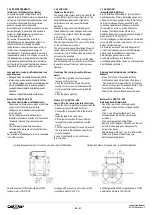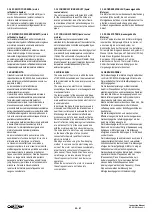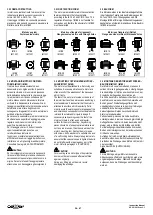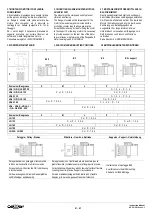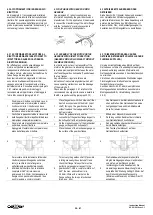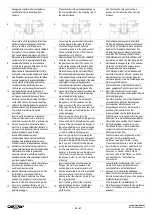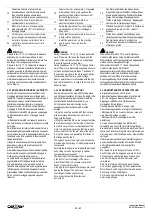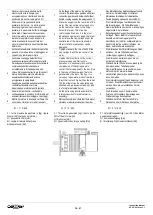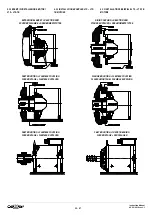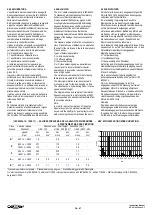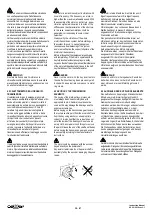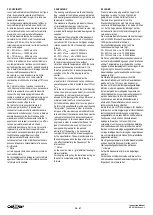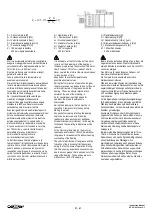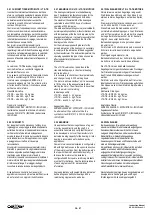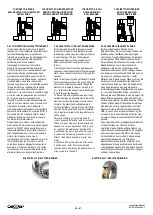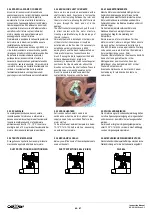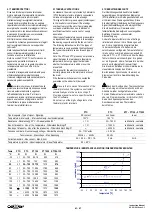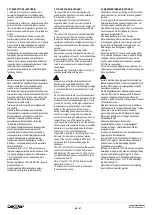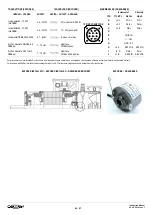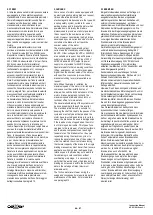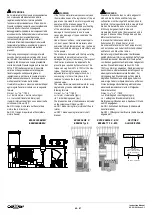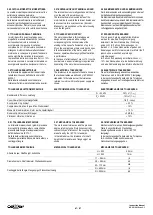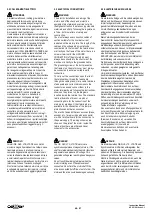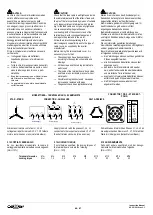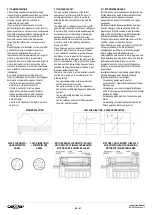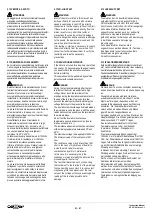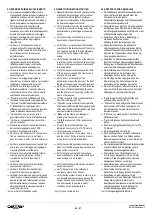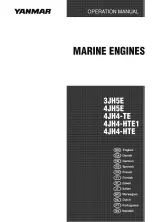
37 - 97
Instruction Manual
AC 02/2019-rev.1.1
p
n
n
r
P
N
D
K
P
F
=
6
10
5
.
19
F
r
= Carico radiale in [N]
P
n
= Potenza nominale in [kW]
N
n
= Velocità nominale in [rpm]
D = Diametro della puleggia in [mm]
P
p
= Peso della puleggia in [N]
K = 1,25 per cinghia dentata
2,35 per cinghia trapezoidale
F
r
= Radial load in [N]
P
n
= Nominal power in [kW]
N
n
= Nominal speed in [rpm]
D = Diameter of pulley in [mm]
P
p
= Weight of pulley in [N]
K = 1,25 for cog belts
2.35 for V-belts
F
r
= Radialbelastung in [N]
P
n
= Nennleistung in [kW]
N
n
= Nenndrehzahl in [U/min] (rpm.)
D = Riemenscheibendurchmesser in [mm]
P
p
= Riemenscheibengewicht in [N]
K = 1,25 bei Zahnriemen
2,35 bei Keilriemen
Al primo avviamento del motore è consigliabile
eseguire il rodaggio dei cuscinetti. Aumentare la
velocità del motore progressivamente da 0 al
70% circa di n
max
in 20 minuti circa.
Non fare mai funzionare il motore per lunghi
periodi alla velocità max.
Tenere sotto controllo la temperatura ed
eventuali rumori anomali.
Nei primi minuti di funzionamento è avvertibile un
rumore più elevato del normale dovuto alla non
uniforme distribuzione del grasso all’interno del
cuscinetto. La rumorosità deve rientrare nella
normalità alla fine del rodaggio.
Per i cuscinetti speciali (alta velocità per
mandrini) il rodaggio è indispensabile.
Durante il rodaggio il ventilatore deve essere
mantenuto in funzione. Fissare la chiavetta
saldamente prima di avviare il motore.
Eventuali guarnizioni od anelli di tenuta posti a
protezione del cuscinetto possono essere rimossi
solo se non necessari allo scopo (ambiente
particolarmente pulito, protezioni meccaniche
esterne supplementari). In questo modo si
diminuirà l
’attrito e la temperatura di esercizio.
Al primo avviamento far funzionare il motore
per 15min circa a velocità ridotta. Questo
permetterà al grasso di distribuirsi
uniformemente senza provocare
surriscaldamenti del cuscinetto.
La distribuzione uniforme del grasso e la
formazione del film lubrificante avviene durante
le prime 30 ore circa di funzionamento. Durante
questo periodo si possono avvertire rumori
inusuali dovuti al grasso in eccesso che viene
spinto fuori dalla gabbia del cuscinetto. Questi
rumori non sono indice di malfunzionamento o
difetto del cuscinetto.
It is advisable, at the first start up of the motor,
to carry out the breaking-in of the bearings.
Increase progressively the velocity of the motor
from 0 to about 70% of n
max
in about 20 min.
Never operate the motor at the maximum speed
for long periods of time.
Keep under check the temperature and
possible abnormal noises.
During the first minutes of operation, a higher
than normal noise can be heard, due to the non
uniform distribution of the grease inside the
bearing. The noise should return back to
normal at the end of the breaking-in.
As for special bearings (high speed for
spindles), the break-in operation is
unavoidable.
During the breaking-in, the fan must be in
operation. Clamp securely the key before
starting the motor.
Any gaskets or seals protecting the bearing
seats can be removed only if required
(particularly clean environment, additional
external mechanical protection). In this way the
friction and the operating temperature will be
reduced.
At the first commissioning run the motor at
reduced speed for about 15min.This will allow
the grease to spread smoothly without causing
overheating of the bearing.
The uniform distribution of the grease and the
formation of the lubricating film takes place
during the first 30 hours of operation. During
this time you may experience unusual noises
due to excess grease that is pushed out of the
cage of the bearing. These noises are not a
malfunction or lack of the bearing.
Beim ersten Anlaufen des Motors ist es ratsam, die
Lager einlaufen zu lassen. Die Motordrehzahl in
etwa 20 Minuten fortschreitend von 0 bis circa 70%
von nmax steigern.
Den Motor nie für einen längeren Zeitraum mit
maximaler Drehzahl laufen lassen.
Die Temperatur und eventuelle abnormale
Geräusche kontrollieren.
Während der ersten Minuten der Inbetriebnahme
kann man ein lauteres Geräusch hören, das auf die
ungleichmäßige Verteilung des Schmiermittels im
Lager zurückzuführen ist. Dieses Geräusch muß
sich nach Beendigung des Einlaufens wieder
normalisieren.
Für die Speziallager (Hochgeschwindigkeitslager
für Spindelantriebe) ist das Einlaufen unerläßlich.
Während des Einlaufens muß das Gebläse in
Funktion bleiben. Vor dem Anlaufen des Motors die
Passfder gut befestigen.
Eventuelle Dichtungen oder Dichtungsringe als
Lagerschutz dürfen nur entfernt werden, wenn sie
nicht zweckdienlich sind (in besonders sauberer
Umgebung, oder bei zusätzlichen äußeren
mechanischen Schutzmaßnahmen). Auf diese
Weise werden Reibung und Betriebstemperatur
herabgesetzt.
Bei der ersten Inbetriebsetzung den Motor für ca.
15 Min. mit reduzierter Drehzahl laufen lassen.
Dadurch kann sich das Fett gleichmäßig verteilen,
ohne Überhitzung des Wälzlagers. Die
gleichmäßige Ausbreitung des Fettes und Bildung
eines Schmierfilms geschieht während ersten ca.
30 Betriebsstunden. Dabei können ungewohnte
Geräusche durch den Austritt des überschüssigen
Fettes aus dem Lagerkäfig auftreten. Diese
Geräusche sind keine Zeichen einer Fehlfunktion
oder eines Lagerdefektes.

